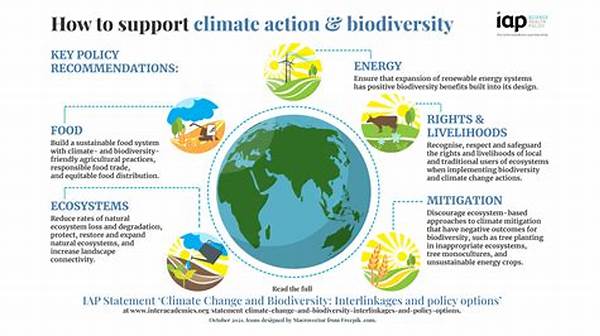The phenomenon of climate change has emerged as a pivotal challenge, with profound ramifications on global biodiversity. As the climate undergoes significant shifts, the diverse species inhabiting our planet are encountering unprecedented pressures that threaten their survival and disrupt ecological balance. This article delves into the multifaceted ways in which climate change is impacting biodiversity, exploring the consequences and potential solutions to mitigate these effects.
Read Now : **reducing Complexity In Legacy Systems**
Climate Change and Ecosystem Disruption
The impact of climate change on biodiversity is pervasive and multifaceted, affecting ecosystems at every level. As global temperatures rise, the habitats of numerous species are being altered, leading to shifts in geographical ranges, altered food availability, and changing reproductive patterns. Entire ecosystems, from coral reefs to rainforests, are experiencing stress as they struggle to adapt to these rapid changes. This disruption is not merely theoretical but has been observed through shifts in species migration, increased extinction rates, and loss of habitat. The delicate balance within ecosystems is being disrupted, leading to declines in species that are unable to adapt or migrate. Consequently, the impact of climate change on biodiversity is both direct, affecting individual species, and indirect, altering ecosystem interactions and functions.
Extinction Risks and Species Vulnerability
Habitat Loss and Fragmentation
The impact of climate change on biodiversity manifests prominently through habitat loss and fragmentation. As temperatures climb and precipitation patterns shift, many species are forced to migrate to new areas to find suitable living conditions. This migration is often impeded by human-induced barriers such as urbanization or agriculture, leading to fragmented habitats. Fragmented landscapes reduce genetic diversity, weaken population resilience, and increase the likelihood of local extinctions. Moreover, species that cannot move or adapt quickly enough face imminent danger of being wiped out. The geographic range is a critical factor; species with limited ranges are more vulnerable when their already restricted habitats shrink or disappear altogether. As such, the impact of climate change on biodiversity is intricately linked with habitat stability and connectivity.
The interplay between climate change and habitat fragmentation underscores the urgency of addressing this global issue. Conservation efforts must prioritize creating corridors that allow species to move as they adapt to changing conditions. Protecting existing natural habitats and restoring degraded ones can alleviate some of the pressures on biodiversity. Furthermore, understanding the specific needs of species that are particularly susceptible to climate changes, such as amphibians and alpine flora, can guide targeted conservation strategies. In doing so, the impact of climate change on biodiversity may be mitigated, preserving both individual species and broader ecological dynamics.
Adaptation and Mitigation Strategies
Addressing the impact of climate change on biodiversity requires a multifaceted approach:
1. Developing climate-responsive conservation strategies that anticipate and mitigate future changes.
2. Enhancing habitat connectivity to facilitate species migration in response to shifting climates.
3. Promoting genetic diversity to bolster species’ resilience to environmental changes.
4. Integrating climate change considerations into existing biodiversity action plans.
5. Fostering global cooperation to ensure cohesive and effective responses to climate-induced biodiversity loss.
6. Mobilizing financial and technical resources for research on climate-biodiversity interactions.
Read Now : Next-generation Research Evaluation Metrics
7. Educating communities on the implications of climate change and biodiversity interconnections.
8. Encouraging sustainable practices that reduce climate change contributors.
9. Implementing policy frameworks that protect vulnerable species and ecosystems.
10. Recognizing indigenous knowledge and its role in managing ecosystems sustainably.
Socioeconomic Implications of Biodiversity Loss
The impact of climate change on biodiversity extends beyond ecological concerns, notably affecting socioeconomic systems. Healthy and diverse ecosystems provide a multitude of services critical to human survival, including food, clean water, and medicine. Biodiversity underpins the natural processes that sustain life on Earth, serving as a buffer against environmental challenges, and contributing to human well-being. As climate change exacerbates biodiversity loss, communities worldwide face threats to food security, as declining fish stocks and changing agricultural conditions disrupt traditional food supplies. This impact of climate change on biodiversity can increase economic instability, particularly in regions heavily dependent on natural resources.
Furthermore, climate change-induced biodiversity loss affects cultural practices and social structures, particularly in indigenous communities whose identities and livelihoods are closely tied to their natural environments. Such changes may lead to social displacement and conflicts over diminishing resources. Economic costs also increase due to the need for climate adaptation measures and the loss of ecosystem services previously provided by a healthy environment. Science and policy must collaborate to address these intertwined challenges, recognizing that sustainable economic development is contingent on healthy ecosystems. By acknowledging and addressing the socioeconomic ramifications of biodiversity loss, we can better appreciate the true cost of the impact of climate change on biodiversity and work towards more harmonious coexistence with our natural world.
Conservation Efforts and Future Prospects
In looking to the future, the focus must be sharpened on conservation efforts aimed at mitigating the impact of climate change on biodiversity. Innovative conservation techniques, such as assisted migration and ex-situ conservation, offer promising methods for safeguarding species. Furthermore, the implementation of protected areas and reserves is crucial, as they provide safe havens for species threatened by habitat changes. Building ecological corridors that link fragmented habitats can enhance species’ ability to move and adapt, reducing extinction risks. Science-based policy and global cooperation are essential in addressing these challenges on an international scale.
Efforts to combat the impact of climate change on biodiversity must also prioritize community involvement and education. Engaging local stakeholders ensures that conservation strategies are culturally relevant and practically applicable. Indigenous communities offer invaluable insights into sustainable practices that have preserved biodiversity over generations. At the governmental level, enforcing regulations that reduce greenhouse gas emissions can indirectly benefit biodiversity by stabilizing climate conditions. To ensure a viable future, the global community must commit to reducing anthropogenic pressures on the environment and actively work to restore ecological balance. Preserving biodiversity is not just a response to climate change but a comprehensive approach to fostering environmental resilience.
